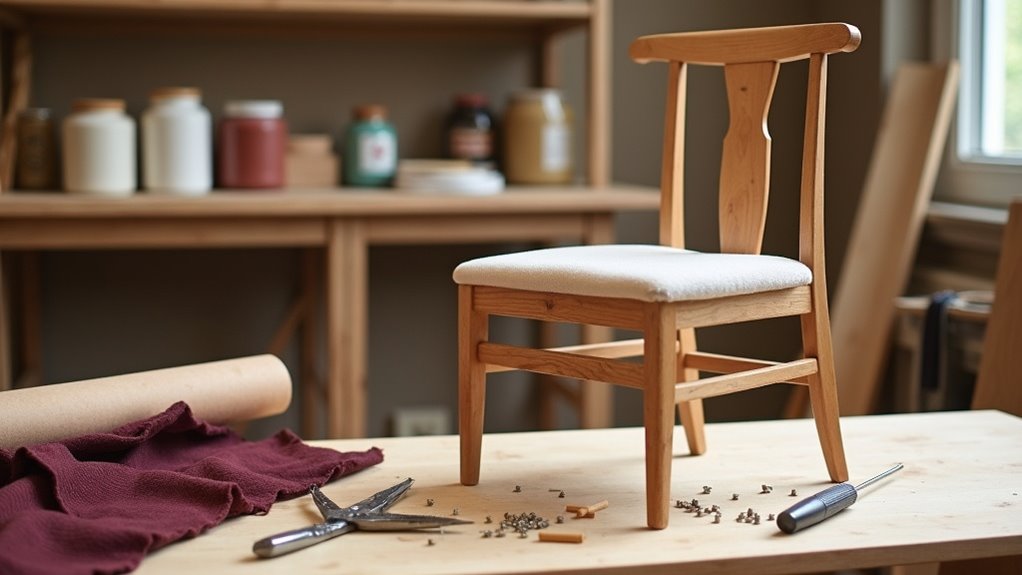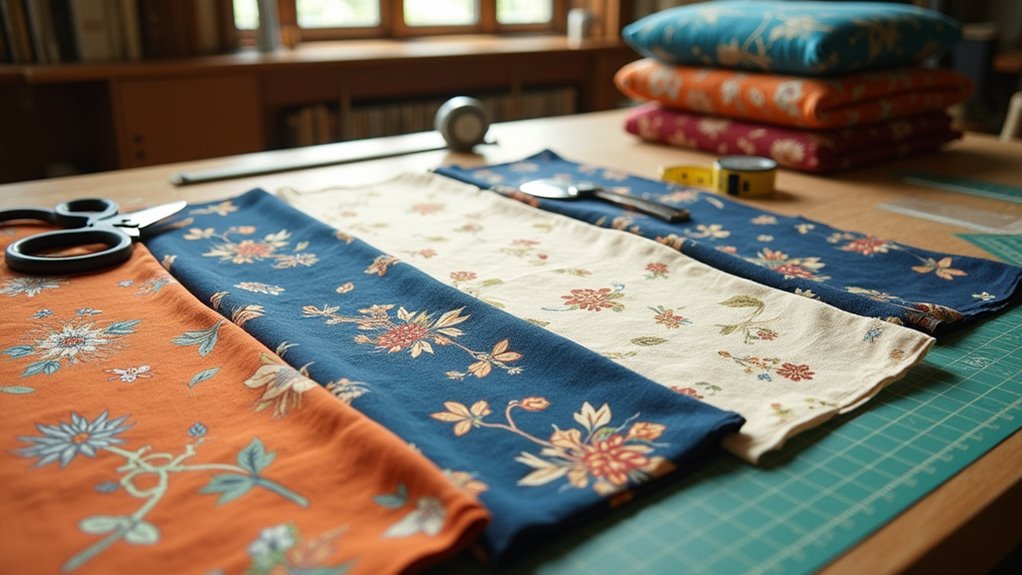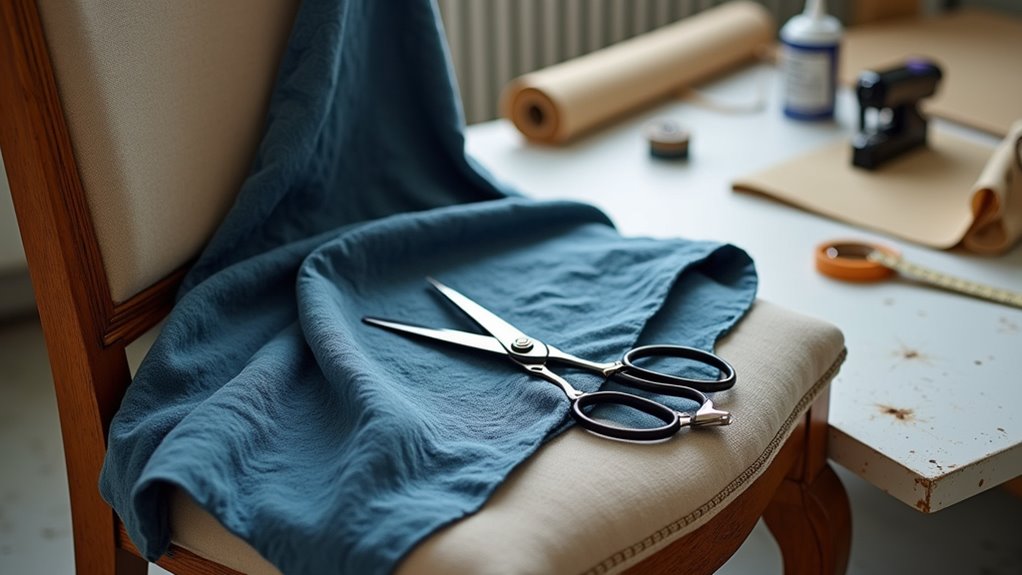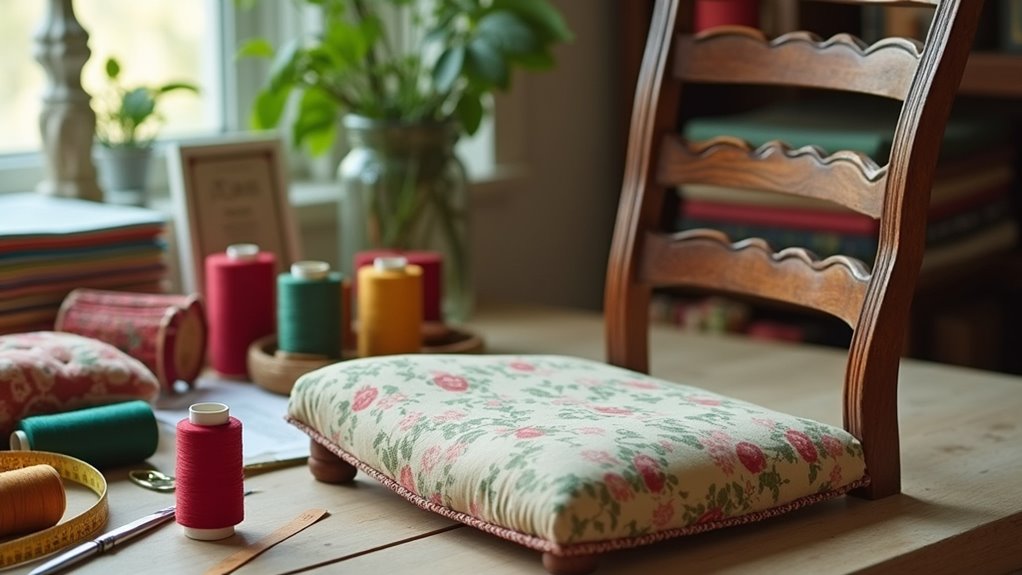How to Restore Old Fabric on Chairs
This post contains affiliate links. As an Amazon Associate, we earn from qualifying purchases.
To successfully restore old chairs, begin by cleaning the fabric thoroughly and vacuuming to eliminate any dust. If the fabric is water-safe, create a gentle wash using dish soap and water. After that, carefully disassemble the chair to inspect for any damage, making repairs with sturdy glue or new padding as needed. Select a durable fabric, accurately measure the required amount (including extra for seams), and cut it out. Finally, staple the new fabric tightly, ensuring corners are folded neatly. For those interested in a deeper understanding, further explanations and details will follow later in the article.
Essential Facts in 30 Seconds
- Clean the fabric by vacuuming and using a gentle soap solution for stains and dirt.
- Dismantle the chair carefully, documenting the process for reassembly and inspecting for frame damage.
- Repair the chair frame and replace old padding with high-density foam for improved comfort and stability.
- Measure and cut new upholstery fabric accurately, allowing extra material for seams and patterns.
- Secure the fabric tightly with staples, focusing on pleats and corners for a professional finish.
Preparing and Cleaning the Fabric
To breathe new life into old chairs, start with preparing and cleaning the fabric. Vacuum every inch of the upholstery. Use a hose, upholstery brush, and crevice tool to remove dust and crumbs. Pay close attention to seams and crevices. They hide dirt well.
Check the fabric cleaning code. For code “X,” skip liquids. Stick to vacuuming and dry brushing. For water-safe fabrics, mix one teaspoon of dish soap in a gallon of warm water. Always test this mixture in a small area first. This helps avoid surprises. Remember to clean spills and stains immediately to prevent setting. Additionally, vacuuming thoroughly is essential for effective stain removal. A thorough vacuuming process helps prevent dirt from embedding deeper into the fabric. Regular cleaning ensures the material’s longevity, enhancing the overall appearance of your chairs.
Wipe the fabric from top to bottom. Don’t over-saturate it. Remember, you’re the superhero of this fabric.
With good care, you can revive those chairs. Spilled ketchup? No worries. You can make that stain disappear like magic!
Dismantling and Inspecting the Chair

[Dismantling and inspecting your chair is an important step before restoring it. Start by taking off the cushions and seat pads. Set them aside for your later work.
Flip the chair upside down. Look for screws and bolts that hold the frame together. Use a screwdriver and pliers to carefully remove these fasteners. Keep track of their sizes and where they belong.
Get ready to check the upholstery. Use a staple remover to take out any staples or tacks. Do this gently to avoid damaging the fabric or frame. Inspect the chair frame for any damages or loose joints needing repair before reupholstering. It’s crucial to inspect for issues such as wobbly legs or sagging seats during this phase. Additionally, check for structural integrity to ensure the chair can support new upholstery properly. Make sure to assess foam padding as well, especially if the old padding is worn and needs replacement.
As you remove the fabric, work from the bottom up. Take notes and pictures to help you remember how to put everything back together. This will help you keep the pattern and ensure smooth reassembly.
Patience is important during this process. Rushing can lead to mistakes. Enjoy the dismantling!
Repairing the Chair Frame and Padding
Now that the chair is taken apart, it’s time for repairs. Start by checking the frame. Look for splits or cracks. Use a strong glue, like epoxy, for any damage. Clamp the areas until the glue sets. This will make the frame strong and stable. Be sure to assess the frame’s structural integrity to ensure no further issues will arise. Additionally, ensure that all screws or fasteners are tightened to enhance the chair’s overall stability. Furthermore, check for any wobbly legs and tighten loose screws if necessary.
Next, inspect the padding. Old padding can feel flat and uncomfortable. Replace it with high-density foam or batting. This will make your chair cozy again. Make sure to secure the new padding well. This prevents lumps from forming later. Regular maintenance can prolong the chair’s lifespan and prevent future issues. Check the springs, too. Tighten or replace any springs that seem weak. These fixes will make your chair sturdy and comfy. Picture relaxing in your newly repaired chair. Maybe even enjoy a movie night in style!
Choosing and Cutting New Fabric

Get ready to pick the perfect fabric for your chairs. Choose something strong and durable. Synthetic fibers are excellent for this. They resist spills and wear well during cozy movie nights. Selecting the right upholstery fabric can make a significant difference in the longevity of your chairs. Additionally, consider how to attach new fabric securely to ensure a professional finish.
Measure your chair carefully. Take your time to get the right size. Don’t forget to add extra fabric for tricky cuts. A little extra goes a long way. Nobody wants to deal with a fabric shortage. Enjoy your project! Additionally, consider selecting durable upholstery fabric to ensure your chairs remain looking new for years to come.
Selecting Durable Upholstery Fabric
Picking durable upholstery fabric for your chairs can be fun! Start by checking out different fabric types. Polyester and microfiber are great choices. They resist stains and are easy to clean. These fabrics work well in busy homes. Additionally, choosing durable upholstery fabric can significantly enhance the longevity of your chairs.
Got kids or pets? Choose fabrics that handle spills easily. Cotton offers a cozy feel, too. Just look for stain-resistant finishes. Consider also foam or batting for cushioning, as it adds comfort to your seating experience.
Think about how to care for the fabric. Colorfastness matters. This keeps your chairs looking fresh and new. Grab a swatch and feel the textures. Additionally, consider upholstery fabric for durability and style as it can enhance both the functionality and aesthetic of your chairs.
Make your choice wisely. A good fabric will keep your chairs looking fabulous for years!
Accurate Measuring Techniques
Measuring chairs accurately can feel tricky, but it’s easy with the right steps. Start by using your measuring tools to find the widest part of the chair. Measure the seat width from one front leg to the other. Add at least 4 inches for seams.
Next, measure the length from the front center to the back center, also adding 4 inches. For armchairs, measure at the widest points, including any curves. Additionally, ensure that you replace cushioning if it is worn out, as this will affect the overall comfort and appearance of the chair. Proper padding replacement can significantly enhance the chair’s usability and aesthetic appeal.
Don’t forget to write down the width and height of the upholstery area before taking anything apart. If your fabric has a pattern, remember to account for repeats. Additionally, accurate measurements will ensure that you have enough fabric to securely cover the entire seat without gaps.
With these simple tips, you’ll ensure accurate measurements. This will make your reupholstery project much easier. You’ll feel confident in your work.
Proper Fabric Cutting Methods
Get ready to cut your new fabric with confidence! Start by choosing a strong upholstery fabric like microfiber or leather. Additionally, consider the thickness of the fabric, as this can affect the fabric tension during the upholstery process.
Measure your chair carefully. Add 10-30% extra fabric for seams and patterns. Unroll the fabric on a flat surface to prevent twisting. Make sure it’s squared off for straight cuts.
Use sharp scissors or a rotary cutter. A metal square helps guide your cuts accurately. Cut out simple shapes, like rectangles. Don’t flip the pieces around. Lay them out according to the grain direction.
Mark each piece with chalk or tape. Always note the grain direction. Additionally, ensure you have appropriate tools ready to facilitate a smooth recovery process.
Keep everything organized. Soon, you’ll have your fabric ready for a beautiful chair makeover!
Applying Fabric and Upholstery Techniques

Your fabric is cut and ready.
Now, it’s time to secure it on the chair. Start by stapling the fabric tightly. Stretch it out to prevent wrinkles. A smooth seat looks best.
Pay attention to pleats and folds. They add style and elegance. Your chair will look like it belongs in a fancy magazine.
Enjoy your newly upholstered chair!
Stapling Fabric Securely
Give your chairs a fab makeover by stapling fabric securely. Use solid stapling techniques to ensure everything holds tight. Here’s how to do it:
- Start by loosely tacking the fabric on all sides. This helps you get it just right.
- Pull the fabric taut but don’t overdo it. No one likes a wrinkly chair!
- Handle corners carefully. Fold them neatly for a smooth finish. Add extra staples to keep everything in place.
With these steps, your chairs will look great and last longer. Enjoy your refreshed furniture!
Creating Pleats and Folds
Pleats and folds can give your chairs a polished look. Start by measuring and marking your pleats. Aim for about 3 inches wide, including allowances. Consistency matters!
Use fold techniques like tuck and roll for added depth. Fold the fabric in order and stitch each pleat down securely. For corners, fold like wrapping a present. Pull the fabric taut to keep the folds smooth. Nobody likes puckers!
Follow these steps, and your chairs will impress everyone. Grab your tools and make those chairs shine!
Adding Finishing Touches
After mastering those neat pleats and folds, it’s time for the finishing touches on your chair makeover! Focus on making sure your fabric pattern lines up perfectly.
Follow these steps to wrap things up:
- Trim any extra fabric. This keeps a sleek look without bulges.
- Use a light cotton layer on larger surfaces for a smooth finish.
- Staple from the center out. Pull the fabric tight but not too tight. Think of it like a snug hug!
Double-check the tension of your fabric. Make any small tweaks if needed.
Finally, step back and admire your work! You’ve turned that chair into something special.
Conservation and Alternative Restoration Methods

Restoring old fabric on chairs requires care and attention. Focus on conservation by using gentle methods. Stabilize your chair without excessive changes. Use thin patches for tears and apply heat-sensitive glues carefully. Keep the original upholstery materials as intact as possible.
For decorative finishes, choose non-intrusive fastening methods. Glue nail heads instead of hammering them in. This prevents damage to the frame.
When replacing stuffing, use materials similar to the originals, like sterilized horsehair.
Document your process with photos. This helps keep a record for future restorers. Get ready to bring your chair back to life!
Frequently Asked Questions
How Can I Determine if My Fabric Is Worth Restoring?
To decide if your fabric is worth restoring, check its condition closely. Look for physical damage like tears or rips. Notice any stains or discoloration. Think about past repairs. Are they well done?
Next, consider the cost of restoration. Will it be expensive? Compare this cost to the fabric’s value. Is it a family heirloom? Does it have historical importance?
If the fabric holds special meaning or is rare, it may be worth the investment. Trust your instincts. Sometimes, sentimental value outweighs the cost.
What Tools Are Essential for Chair Restoration Projects?
Chair restoration needs important tools. Use a staple gun to attach fabric securely. Pliers help pull out old staples easily. Scissors are essential for cutting fabric and padding.
Quality restoration supplies matter too. Choose strong fabric and padding for durability. Don’t forget to have a measuring tape handy. It ensures you cut everything to the right size.
With these tools, you can restore chairs with precision. Enjoy the process and see your old chairs come back to life!
How Do I Choose the Right Upholstery Fabric Weight?
Fabulous fabric choices start with durability and patterns. For strong furniture, choose heavy-weight materials. They last longer and resist wear. Medium-weight fabrics work for lighter uses, like cushions or curtains. Always match the fabric weight to your furniture’s purpose. This ensures comfort and lasting satisfaction. Remember, the right fabric makes all the difference!
Can I Restore Fabric Without Completely Reupholstering the Chair?
Restoring fabric without reupholstering is possible. Start by cleaning the fabric to get rid of dirt. After cleaning, use patch techniques to fix any tears. This method will refresh your chair’s look. It saves both time and money. You don’t need to spend a lot to make your chair beautiful again. With some effort, you can give your furniture a new life. Enjoy your newly restored chair!
What Are the Common Mistakes to Avoid During Restoration?
Restoration projects can be tricky. Many people make mistakes that lead to unsatisfactory results. Planning is key. Take your time to organize every step. Cleaning the fabric is very important. Use the right materials for the job. Always secure everything properly. This helps ensure a successful outcome. Don’t rush. Focus on each detail. Avoid shortcuts that can harm your project. Pay attention to the little things. They matter a lot. With careful planning and execution, your restoration can be a success.
Conclusion
You did a fantastic job restoring that old chair. It’s like giving it a brand-new life! Every step you took made it special and unique. Remember how you turned it from dull to vibrant. Keep your tools close. Don’t be afraid to take on more projects. With practice, you’ll become a furniture expert. You can make stains and rips vanish like magic. Celebrate your hard work!
